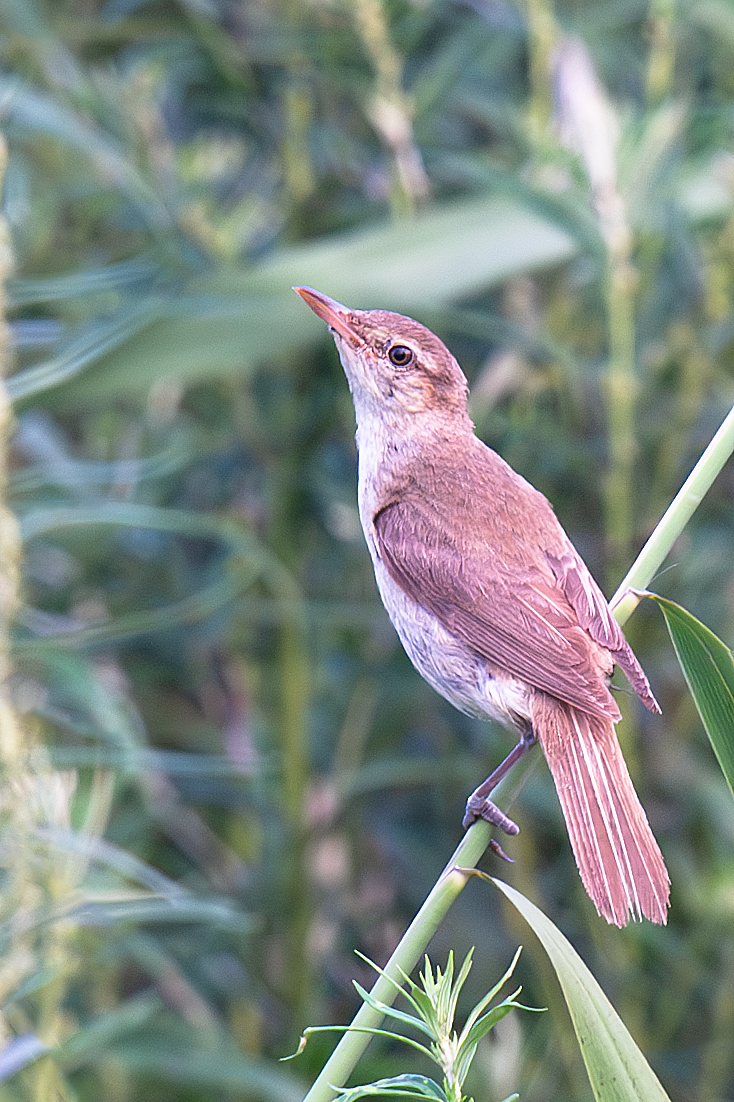
Oriental Reed Warbler Acrocephalus orientalis breeds across much of temperate eastern Palearctic, in China from Heilongjiang to Gansu, Sichuan, Fujian, and Shanghai, where breeds Cape Nanhui and Chongming Island. Winters Southeast Asia and southeast China. HABITAT & BEHAVIOR Very much associated with wetlands, breeding in reedbeds in coastal marshlands, along lakes and rivers, and near agricultural land. Leaps heavily from reed to reed, searching for invertebrates amid the dense vegetation. Males sing loudly from atop reed. ID & COMPARISON Closely resembles Clamorous Reed Warbler A. stentoreus amyae. Distinguished with difficulty from Great Reed Warbler A. arundinaceus zarudnyi, which breeds in Xinjiang. The most common large reed warbler in China, readily distinguished by size from the smaller Acrocephalus. Has conspicuous whitish supercilium that extends to ear coverts, brown loral line or spot, and an ill-defined brown eye-stripe immediately behind eye. Fairly uniform olive-brown from crown to tail, but darker brown alula, exposed primaries, and centers to tertials offer some contrast. Underparts creamy white, purer white on throat and belly, and with a warm buffish wash on flanks and vent. Throat shows fine brown streaking, and tail has well-defined whitish tips. Clamorous Reed Warbler and Great Reed Warbler have fainter (or no) throat streaking and either no (Clamorous) or less conspicuous (Great) whitish tips to rectrices. Clamorous has in addition a shorter supercilium, slightly shorter primary projection, and a longer tail. Thick-billed Warbler Arundinax aedon lacks supercilium and eye-stripe, has pale lores, and prefers drier habitats. BARE PARTS Long, heavy, almost thrush-like bill grey above, pink below, with greyish tip to lower mandible; feet grey. VOICE Loud song consists of dry calls strung together into repetitive chatter, each sequence lasting 6–8 seconds. — Craig Brelsford
SOUND-RECORDINGS
Oriental Reed Warbler Acrocephalus orientalis, Cape Nanhui (30.920507, 121.973159), Shanghai, early May, by Craig Brelsford (1:00; 3 MB)
Oriental Reed Warbler, Jiulong Reservoir (45.706874, 130.517068), Boli, Heilongjiang, China, elev. 300 m (980 ft.), mid-June, by Craig Brelsford (0:05; 2 MB)
THE REED WARBLERS OF CHINA
shanghaibirding.com covers most of the species in China in the family Acrocephalidae. Click any link:
Great Reed Warbler Acrocephalus arundinaceus
Oriental Reed Warbler A. orientalis
Clamorous Reed Warbler A. stentoreus
Black-browed Reed Warbler A. bistrigiceps
Moustached Warbler A. melanopogon
Sedge Warbler A. schoenobaenus
Speckled Reed Warbler A. sorghophilus
Blunt-winged Warbler A. concinens
Manchurian Reed Warbler A. tangorum
Paddyfield Warbler A. agricola
Blyth’s Reed Warbler A. dumetorum
Eurasian Reed Warbler A. scirpaceus
Thick-billed Warbler Arundinax aedon
Booted Warbler Iduna caligata
Sykes’s Warbler I. rama
Eastern Olivaceous Warbler I. pallida
ACKNOWLEDGEMENTS
Daniel Bengtsson served as chief ornithological consultant for Craig Brelsford’s Photographic Field Guide to the Birds of China, from which this species description is drawn.
